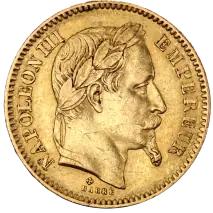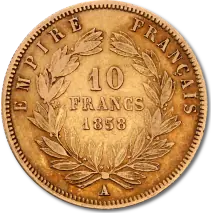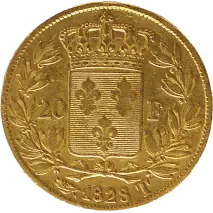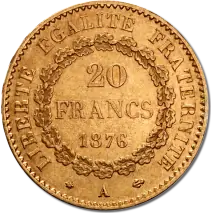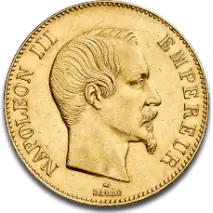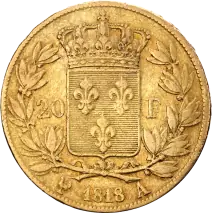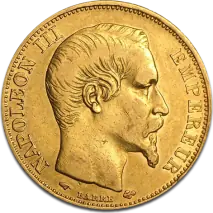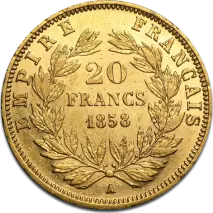French Franc Coins
Buying French Franc gold coins: History, Culture and Finesse in gold bullion coins
The french franc was the official currency of France from 1360 until the introduction of the euro in 1999, and a commonly held international reserve currency in the 19th and 20th centuries.The first franc was a gold coin introduced in 1360 to pay the Ransom of King John II of France. This coin showed Francorum Rex ("King of the Franks" in Latin) on a richly decorated horse (franc à cheval- freely translated: loyal horse),the two words earning the coin its name.
The franc was re-introduced in decimal form in 1795, and in 1803 the Banque de France was commissioned to produce a gold franc containing 0.29 g of fine gold.The first "modern", post-Revolution gold coins with denominations in francs abandoned the revolutionary symbols of the 1795 coinage, now depicting Napoleon in the stance of Roman emperors, and described as "Bonaparte Premier Consul", while the country was labeled "Republique Française". Soon the republican pretense faded: in 1804, the obverse legend changed to "Napoleon Emperor", abandoning his family name in the manner of kings.
In 1807, the reverse legend changed to describe France as an empire, not a republic. In analogy with the old Louis d'or (gold) coins, these gold francs were called Gold Napoleons and, being sound money were a great success and became world famous even after Napoleon's fall. Succeeding governments kept Napoleon's weight standard, and accordingly adopted designs which traced the political history of France.
The 20 franc LOUIS XVIII gold coin is a typical example of the period, displaying the crown on top of the Flour de Lis shield and coat of arms on the reverse side. This currency system based on the gold franc was retained during the Bourbon Restoration and perpetuated until 1914 with the 20 franc gold "Roosters" being very popular as the culmination of the gold franc period, which ended in WW I. The French people are very passionate and sensitive in all that concerns their cultural heritage and political history. All franc coins are charged with emotion, artistic energy and patriotic spirit, bearing elegant yet powerful designs. Although "modern" gold French franc coins were minted in large quantities, they are of great historical importance and relatively scarce, especially the ones close to uncirculated condition, thus being an excellent choice for coin collectors. They represent excellent value for the price they are offered.
French franc description
The French changed the design many times on both the obverse and the reverse, but the 20 franc gold coin retained the same weight and dimensions, as in the case of the most popular gold "Marianne/Rooster" coins, minted from 1899 to 1914. These traditional French gold coins are 21 mm in diameter, they weigh 6.4516g and are made of 90% pure gold. On the reverse side they display the Gallic Rooster, or Coq Gaulois, one of the national symbols of the France since the Middle Ages. The Gallic Rooster played an important role during the French Revolution as an image of revolutionary vigilance, confidence, and fierceness.
The cockerel is proudly surrounded by the emblem of the French Revolution: LIBERTE EGALITE FRATERNITE. The obverse shows Marianne, the French symbolic expression of liberty and reason. Marianne is a national emblem of the French Republic, an allegory of freedom, right and reason, and a portrayal of the Goddess of Liberty. Marianne is displayed in many places in France, and holds a place of honour in town halls and law courts. In 1999, French actress and model Laetitia Casta was chosen by the French people (in a national survey) to be the new model for the bust of Marianne that stands inside every French town hall.
The production of the French franc coins
The Monnaie de Paris is a state-funded institution responsible for the striking of circulating and collector coins, medals, and official decorations; it contains its historical manufacturing site in the centre of Paris and a plant at Pessac, in the Gironde region of France.
A Neoclassical edifice, the Hôtel de la Monnaie was designed by Jacques-Denis Antoine and built from 1767–1775 on the Left Bank of the Seine. Founded in 864by Charles the Bald, the Monnaie de Paris is the oldest of French institutions. Heir to more than twelve centuries of tradition, the institution has cultivated the highest tradition of metalwork and possesses age-old expertise which it employs with great vitality and creativity.
Engraving in metal the designs of many styles and eras, the Monnaie de Paris entrusts the conception of its products to the greatest artists, and maintains a constant dialogue with contemporary artistic creation. An institution at the service of a Nation, Monnaie de Paris represents a unique heritage, a key institution that promotes French values and culture, an institution that crosses ages, conserving its expertise and maintaining a strong commitment to its customers.
The French Mint Quality Assurance
Over the past 1,000 years coins have been minted at a large number of mints throughout and outside France, although being situated in the capital, the Paris Mint has always been the most important. Gold francs bearing no mintmark or marked with the letter A come from Paris, while other mintmarks are used to show the origin of the coins.
Nineteenth and early 20th century French coinage stands out for the precision and quality of the manufacturing but, above all, the inspirational design, always en vogue with current artistic tendencies, and extremely labour intensive when it comes to producing prestigious coins. Gold francs rightfully claim a special place in every coin collection for their historical significance, their quality of manufacturing and their exquisite design and engraving.
Selling French franc coins
As a leading dealer of gold bullion coins, we are also keen to hear from anybody selling french franc. If you are looking to sell any French francs, contact a member of our friendly team. We promise to offer highly competitive rates and will confirm the price by email.
